In the fast-paced world of biotechnology and pharmaceuticals, where groundbreaking innovations have the power to transform lives and health, one thing stands as the bedrock of progress: Intellectual Property (IP). Whether it’s a life-saving drug, a revolutionary gene-editing tool, or a new diagnostic method, IP is the invisible force that shapes how these innovations are developed, protected, and brought to market. For companies pouring billions of dollars into research and development, securing IP rights is not just a legal formality—it’s a strategic necessity that can determine their success or failure. In an industry where the stakes are incredibly high, understanding the role of IP is crucial for anyone looking to navigate the complex landscape of biotechnology and pharmaceuticals.
Intellectual Property (IP) in the biotechnology and pharmaceutical industries refers to the legal protections granted to innovations, inventions, and creations within these fields. IP plays a vital role in encouraging research, development, and commercialization of new drugs, therapies, and biotechnologies. It helps ensure that the creators of novel products and technologies are rewarded for their efforts, and it also provides incentives for further innovation.
Here’s an overview of the main types of IP in the biotech/pharmaceutical sectors:
Patents
- Definition: A patent grants exclusive rights to an inventor for a certain period (usually 20 years from the filing date) to prevent others from making, using, or selling their invention without permission.
- Importance in Biotech/Pharma: Patents are crucial for protecting novel drugs, therapies, gene sequences, biotech processes, and medical devices. For example, pharmaceutical companies often patent new drug compounds or unique drug delivery methods.
- Patentable Subject Matter: In biotech, patents may cover:
- New chemical compounds or biologics (drugs, antibodies, vaccines)
- Genetically modified organisms (GMO, engineered bacteria)
- Methods of treatment (new medical procedures or diagnostic tests)
- Biotechnology tools (like CRISPR technology or gene-editing tools)
Trade Secrets
- Definition: Trade secrets refer to confidential business information or processes that provide a competitive edge, such as formulas, processes, or manufacturing techniques that are not patented.
- Importance in Biotech/Pharma: Trade secrets are highly valuable for companies that want to protect their proprietary knowledge and processes. For example, pharmaceutical companies may keep the formula for a drug, its manufacturing process, or clinical trial data as trade secrets.
- Example: The formula for Coca-Cola or the specific method used to produce a biologic drug.
Trademarks
- Definition: Trademarks are symbols, names, or other identifiers that distinguish the products of a company from others in the market.
- Importance in Biotech/Pharma: Trademarks are critical for branding and consumer recognition. Pharmaceutical companies often trademark the names of their drugs and even their logos. For example, the name “Lipitor” (a cholesterol-lowering drug) is trademarked, as is the Pfizer logo.
- Example: Trademarked brand names for pharmaceutical products (e.g., “Humira,” “Crestor”).
Copyrights
- Definition: Copyright protects original works of authorship, such as written documents, computer programs, and other creative expressions.
- Importance in Biotech/Pharma: While copyrights are less prominent in biotech/pharma than patents or trade secrets, they can apply to scientific publications, clinical research data, and software used in research.
- Example: A pharmaceutical company might copyright the software developed for drug formulation or the documentation of clinical trial results.
Biosimilars and Biologics
- Definition: Biologics are large, complex molecules derived from living cells. A biosimilar is a product that is highly similar to an approved reference biologic drug but may have slight differences.
- Importance in Biotech/Pharma: When a biologic’s patent expires, competitors can create biosimilars. However, biosimilars must navigate the complexities of patent law and regulatory approval, including demonstrating no significant differences from the original product in terms of safety, efficacy, and quality.
- Example: Biosimilars such as “Zarxio,” a biosimilar to the biologic “Neupogen.”
Regulatory Exclusivity
- Definition: Regulatory exclusivity refers to the period during which a drug is protected from competition based on regulatory approval processes, even if the patent has expired.
- Importance in Biotech/Pharma: Exclusive rights can be granted for a certain period (typically 5 to 12 years, depending on the jurisdiction) to encourage the development of new drugs and biologics.
- Example: The U.S. FDA grants Orphan Drug Exclusivity for certain drugs that treat rare diseases, providing a period of market exclusivity.
IP Challenges in Biotech/Pharma
- Patent Thickets: Biotech and pharma companies often face complex patent landscapes, where multiple patents cover different aspects of a single product. This can make it challenging for competitors to innovate and create new products without infringing on existing patents.
- Patent Life Cycle Management: Managing the life cycle of patents is important. Companies may seek extensions of exclusivity periods (via supplementary protection certificates or pediatric exclusivity) to protect their investment in research and development.
- Litigation and Disputes: IP disputes are common, especially with patents. Legal battles can arise over patent infringement, particularly when generic or biosimilar manufacturers challenge patents before they expire (as seen in “patent cliff” situations).
In the biotechnology and pharmaceutical industries, IP is essential for fostering innovation, protecting investments, and ensuring that companies can secure returns on the considerable costs involved in research, clinical trials, and regulatory approval. It is a highly dynamic and complex area of law, with evolving regulations and practices that impact both innovators and competitors in the field.


